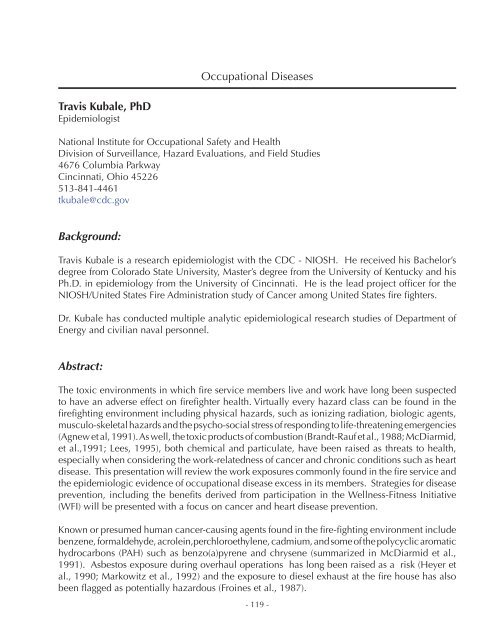Redmond EMS Abstracts.indd - IAFF
Redmond EMS Abstracts.indd - IAFF
Redmond EMS Abstracts.indd - IAFF
You also want an ePaper? Increase the reach of your titles
YUMPU automatically turns print PDFs into web optimized ePapers that Google loves.
Occupational Diseases<br />
Travis Kubale, PhD<br />
Epidemiologist<br />
National Institute for Occupational Safety and Health<br />
Division of Surveillance, Hazard Evaluations, and Field Studies<br />
4676 Columbia Parkway<br />
Cincinnati, Ohio 45226<br />
513-841-4461<br />
tkubale@cdc.gov<br />
Background:<br />
Travis Kubale is a research epidemiologist with the CDC - NIOSH. He received his Bachelor’s<br />
degree from Colorado State University, Master’s degree from the University of Kentucky and his<br />
Ph.D. in epidemiology from the University of Cincinnati. He is the lead project officer for the<br />
NIOSH/United States Fire Administration study of Cancer among United States fire fighters.<br />
Dr. Kubale has conducted multiple analytic epidemiological research studies of Department of<br />
Energy and civilian naval personnel.<br />
Abstract:<br />
The toxic environments in which fire service members live and work have long been suspected<br />
to have an adverse effect on firefighter health. Virtually every hazard class can be found in the<br />
firefighting environment including physical hazards, such as ionizing radiation, biologic agents,<br />
musculo-skeletal hazards and the psycho-social stress of responding to life-threatening emergencies<br />
(Agnew et al, 1991). As well, the toxic products of combustion (Brandt-Rauf et al., 1988; McDiarmid,<br />
et al.,1991; Lees, 1995), both chemical and particulate, have been raised as threats to health,<br />
especially when considering the work-relatedness of cancer and chronic conditions such as heart<br />
disease. This presentation will review the work exposures commonly found in the fire service and<br />
the epidemiologic evidence of occupational disease excess in its members. Strategies for disease<br />
prevention, including the benefits derived from participation in the Wellness-Fitness Initiative<br />
(WFI) will be presented with a focus on cancer and heart disease prevention.<br />
Known or presumed human cancer-causing agents found in the fire-fighting environment include<br />
benzene, formaldehyde, acrolein,perchloroethylene, cadmium, and some of the polycyclic aromatic<br />
hydrocarbons (PAH) such as benzo(a)pyrene and chrysene (summarized in McDiarmid et al.,<br />
1991). Asbestos exposure during overhaul operations has long been raised as a risk (Heyer et<br />
al., 1990; Markowitz et al., 1992) and the exposure to diesel exhaust at the fire house has also<br />
been flagged as potentially hazardous (Froines et al., 1987).<br />
- 119 -

















